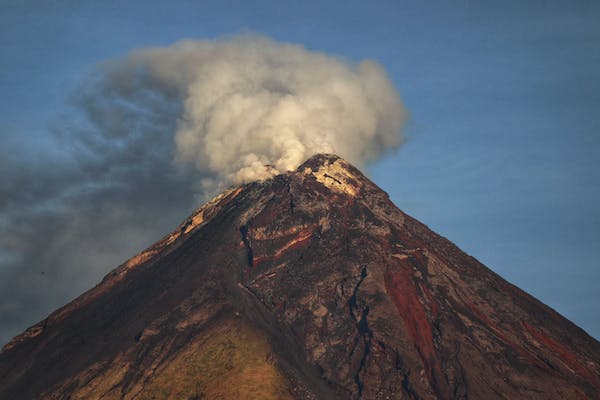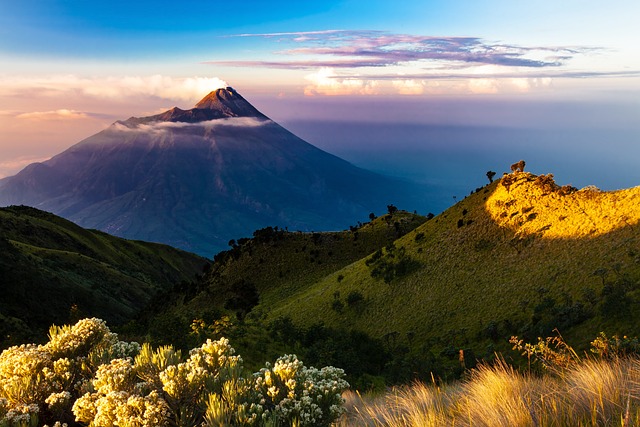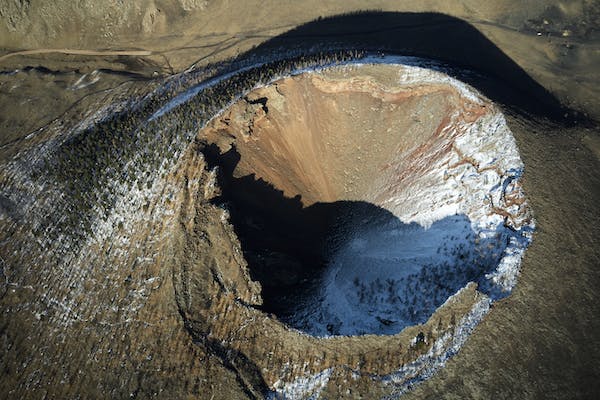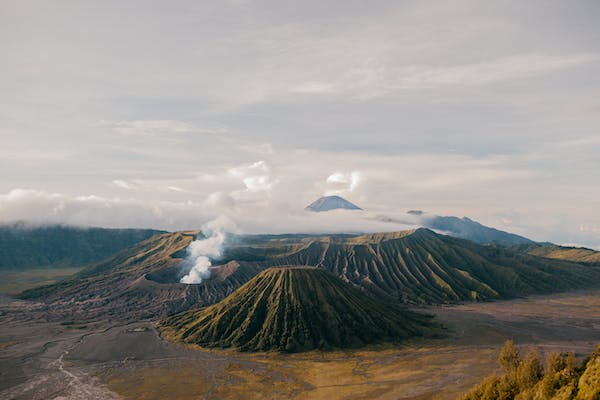Mount Dukono is one of the world’s most active volcanoes, and it hasn’t stopped rising since 1933. Hikers can get close to this scary volcano, and it goes without saying that it’s one of the best hikes in Indonesia.
It’s possible to walk Mount Dukono in one long day, but most people camp on the mountain for two days and one night because it’s less difficult and the views are better. If you’re feeling brave, you can even climb the hole and take a look inside, even though it’s risky.
The fact that not many people know about this hike yet is part of what makes it so special. It’s in a scary, remote part of Maluku, but I’m sure Dukono will become very famous someday. Right now, it’s kind of like Mount Bromo, but there aren’t as many people there.
This trip guide will tell you how to get to Mount Dukono, what to expect on the hike, and anything else you need to know before you go!
How Do I Get To Mount Dukono ?
Mount Dukono is on the island of Halmahera, which is in Indonesia. It is in North Maluku. Tobelo, which has hotels, restaurants, and everything else you might need, is the closest town to the hike. It is a good place to stay before or after the walk.
You can fly to Kao airport (code: KAZ) or Gamar Malamo airport (code: GLX) to get to Dukono. You could also fly to Ternate airport (code: TTE) and take a boat to Halmahera from there, but that would take longer.

Wings Air has several direct flights each week from Manado in North Sulawesi to these airports. There are direct flights from Bali and Jakarta to Manado. On Skyscanner, you can look for flights in Indonesia.
From Manado, we flew to the Kao airport. From there, it took us 1.5 hours to drive to Tobelo town, where we stayed the night before and after the walk.
Mount Dukono’s Best Local Guide
At Dukono, you can’t get around or stay safe without a local help. I would only hike this trail with a guide, even though it costs more.
Almost none of the way is signed, so it would be hard to find your way if you went alone. A guide will know more about what the volcano does and how close you can get to it safely on any given day. If you’re staying at the volcano for the night, they can also set up a porter to take your camping gear, which will make the hike much easier and more fun.
Alex Djangu is a trekking guide who lives on Halmahera island and knows English. He took me on this trip. He is very helpful and knows a lot about the volcano. He has been taking foreign tourists to Mount Dukono and Mount Ibu, another amazing volcano on Halmahera, for many years.
What to Expect When Climbing Mount Dukono
Mount Dukono is a very long and hard walk that can be done in one day, or you can camp near the crater and hike down the next day.
If you stay overnight, you can see the red lava better because it will be dark. You’ll also have the unique chance to fall asleep to the sounds of a volcano erupting.
I chose a one-day walk at Dukono to save time and money, but I would love to camp there someday. Alex and I left at 2 AM on a scooter and drove to the starting place near the village of Mamuya.
• Jungle Trek
The top of the Dukono hill is 1,335 meters (4,380 feet) above sea level, but you’ll start your hike near sea level.
The first part of the Dukono hike goes through bush, but there are some paved parts. You walk up a steep hill the whole way, but there are no rocks or other things that could make it dangerous.

There are a few creek bridges, but when I was there, none of them had water. Flash floods can happen when it rains a lot. The hardest part for us was making sure we didn’t trip over dirt and tree roots.
Along the way, we saw a python, a monitor lizard, some giant centipedes, and several strange birds. The snake was moving right in the middle of the main road, so we had to go around it.
• Dukono Volcano Crater
When we got to the top of the Dukono volcano, we crawled up to the edge of the crater and looked inside while smoke and ash were coming out. It’s a great thing to see. You can also sometimes see red-hot lava.
If the hole is shooting out lava rocks, don’t go near it for your own safety. Dukono sometimes spits out huge lava rocks that land like bombs on the crater’s sides. Getting hit by one of these rocks could kill you. We were lucky that the volcano wasn’t shooting rock bombs when we were there, but we did see some recent bombs on the crater’s slope.
We stayed on the crater rim for about 30 minutes while I flew the drone some more. Then we went back down. At the same time, the noise, heat, and smoke were scary and wonderful.
• Old Lava Field
After hiking for 4 or 5 hours, we came out of the bush and saw the smoking crater for the first time. Already, we could hear it rumbling like a jet engine. This is where you’ll set up your tent if you’re going camping. It’s about 1 or 2 kilometers from the volcano’s crater.
In the next part, you will walk through an old field of black lava until you reach the top of the crater. From here, it doesn’t look too far away, but it takes about an hour or two to walk to the top of the crater at a normal pace. You’ll pass an interesting pool of blue water along the way.

The lava rocks can be hard to walk on, but I liked them better than the bush. We stopped here, and I tried to get a picture of the huge cloud of smoke coming from the volcano by flying the drone for a while.
• Return Hike
It’s easier to go down from Dukono than up, but it’s still not easy. After it rains, the paved parts of the path are steep and slippery. On the way down, it poured hard for an hour or two, and we slipped and fell a lot on the wet sidewalk.
We started going down around 10 a.m., when it was already getting cloudy, and it took us 4 hours to get from the top of the crater to the beginning of the trail, or almost 5 hours if you count the scooter ride and other things.
Alex, my guide, and I spent about 12 hours hiking at Dukono. Most of that time was spent going uphill on rough volcanic ground and muddy jungle trails. Even though we started so early in the night, we were very dirty and very tired.
The next day, I ate a quick meal in Tobelo town and then went to bed, where I slept for about 11 hours. Quite a day!
Is the Dukono volcano still erupting?
Volcano Dukono is always erupting. Since 1933, it has never stopped rising. Alex, my local guide, can be reached at the number I gave you earlier if you have any questions about the current action. He will be happy to help.
The amount of volcanic action at Dukono changes from year to year, but the show is almost always worth seeing. When I went to see it in 2021, it spewed out less ash than usual and didn’t throw as many rock bombs.
Is it safe to go to Dukono Volcano?
As you climb up to the edge of a very active volcano, it’s clear that the general safety of this trek is questionable at best. However, there are ways to reduce some of the risks and still have a great time.

When Dukono throws out rock bombs, that’s when it’s most dangerous. These are huge, and getting hit by one of them could kill you. The rocks can fall on any part of the crater’s slope at any time. At your own risk, go ahead.
If you want to be extra safe, you can just look at the volcano from a distance and don’t go inside the crater. If you have a drone, you can take great shots of Dukono from the old lava field without ever getting close to the rock bombs.
At Dukono, there are sometimes more powerful explosions. This happened in 1550 and killed people and caused damage on the island of Halmahera. Other big storms happened in 1719, 1868, and 1901. You can check Magma Indonesia before you leave to see if there have been any changes.
When to hike up Mount Dukono
If you only want to hike Mount Dukono in one day, you’ll need to get up very early, around 2 AM, and get going. This is because it is a very long walk, and the best time to be at the crater is right after sunrise, when the sky is clear and you can see the eruptions. If you do Dukono as a 2-day walk, you have more freedom with the timing. Even if it’s cloudy or raining when you get there, it should be clear at night or the next morning.
All through the year, it rains a lot in Tobelo. The best time to go hiking is from July to October, when it’s the driest, but I wouldn’t be afraid to go to Dukono at other times of the year. We went to Dukono in June. On the way back down through the jungle in the afternoon, it rained for an hour or two, but that didn’t ruin our walk and didn’t stop me from taking a lot of pictures of the volcano.
Things to carry
The shoes. You must have real camping shoes or boots. The road can be rocky, muddy, or very slippery at different times. If you don’t have good grip, even the parts that are paved can be slippery.
Head light. Because the walk is so long, you need a headlight and extra batteries. You’ll probably start or end the Dukono hike in the dark, so you’ll need to be able to see where you’re going.
An umbrella. During the trek, it’s likely to rain at least once, so it’s a good idea to bring a small, foldable poncho, especially if you need to keep gadgets dry.



